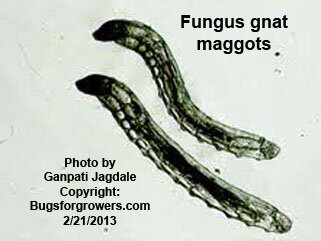Fungus gnat identification
Fungus gnats are about 3-4 mm in size, blackish or grayish colored small flies (Photo 1) with clear wings and they generally look like small mosquitoes. There are three different species of fungus gnat including Bradysia coprophila, B. impatiens and B. difformis exist in nature. These small insects generally found around damp areas and growing algae in the greenhouses and interior landscapes. Females of fungus gnats lay very small, oval, shiny, white and semi-transparent eggs. Fungus gnat larvae are whitish, slender and legless maggots (Photo 2) with translucent bodies and black head capsules whereas their pupae are small and brown in color.
Photo 1. An adult of fungus gnat
Photo 2. Fungus gnat maggots (Larvae)
Fungus gnat life cycle
Fungus gnat females lay over 200 eggs singly or in clusters on the media or soil surface. Eggs hatch into small maggots within a week. They feed on plant tissues and become mature within 2 weeks. Mature maggots then pupate near the soil surface. Adults start emerging from pupae within a week. Thus, fungus gnats complete their life cycle from egg-to- adult stage within 20-25 days. Fungus gnats complete several overlapping generations in a year in the greenhouse at 20-25C.
Fungus gnat damage
Adults of fungus gnat do not cause direct damage to plants but indirectly they cause damage to plants by disseminating spores of many fungal diseases (see below) from plant to plant. Adult fungus gnats are also a nuisance to people. Unlike adults, all the larval (maggots) stages of fungus gnats cause direct damage to many ornamental plants by chewing or stripping and tunneling on their healthy root and stem tissues. These damaged roots and stems cannot absorb water and nutrients from soil or potting media. Maggots are known to cause damage to roots and stems of seedlings, cuttings and young plants. Major symptoms of fungus gnat damage include poor and stunted growth, loss of vigor, yellowing, premature dropping of leaves and death of plants. Like adults, maggots of fungus gnats also disseminate spores of plant diseases like Botrytis blight, Fusarium wilt, Pythium blight and Verticillium wilt from plant to plant while feeding on the plant parts.
Physical and cultural control of fungus gnats
Following physical and cultural practices are cost effective and environmentally safe alertantives in reducing the populations of fungus gnats in the greenhouses and interior land scapes.
Trapping and killing
The yellow sticky cards (Photo 3) are generally used for monitoring the population of fungus gnats but these cards can also help to reduce the population of fungus gnats. This is because actively flying adults of fungus gnats get stuck to the cards and die. Since trapped females of fungus gnats die quickly, they cannot lay eggs that in turn disrupt the life cycle of fungus gnats as their future generations will not be produced. For trapping flying adults, cut yellow sticky traps into small pieces, attach them to small wood sticks and place them in several pots. To attract fungus gnat maggots, cut small pieces of potatoes and place them on the surface of the media overnight. The next morning, collect popto pieces with trapped maggots and destroy them. Repeat this process several times until no more maggots are attracted to potato pieces.
Photo 3. Yellow sticky cards
Cultural control of fungus gnats
Avoid overwatering: Since fungus gnat maggots like very high moisture levels in the media for their survival and development, allow the soil media to dry as much as possible without hurting growing plants between waterings. Remove standing water, moist vegetation, spilled compost or media from floors, decomposing vegetation. Avoid overwatering and improve drainage of potting medium. Following these practices will eliminate breeding spots of fungus gnats that in turn will reduce their population and damage caused by them.


